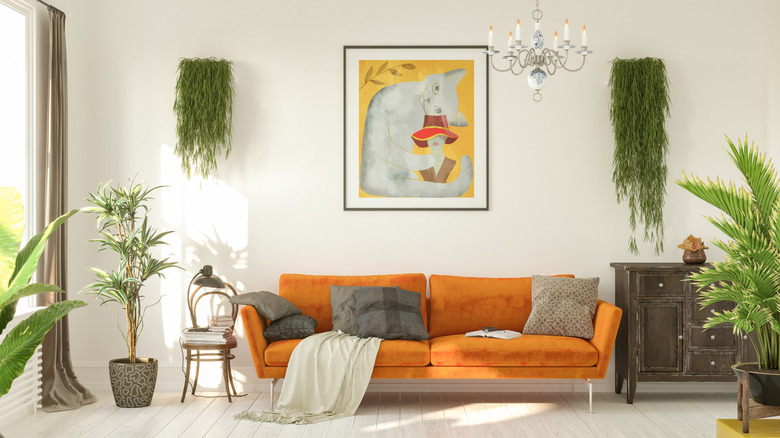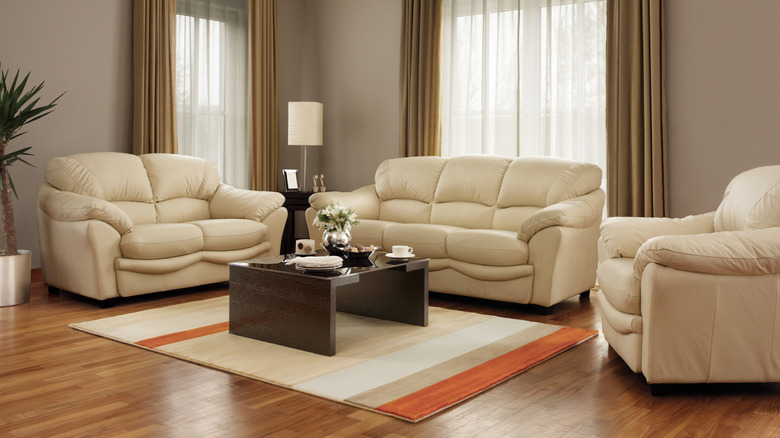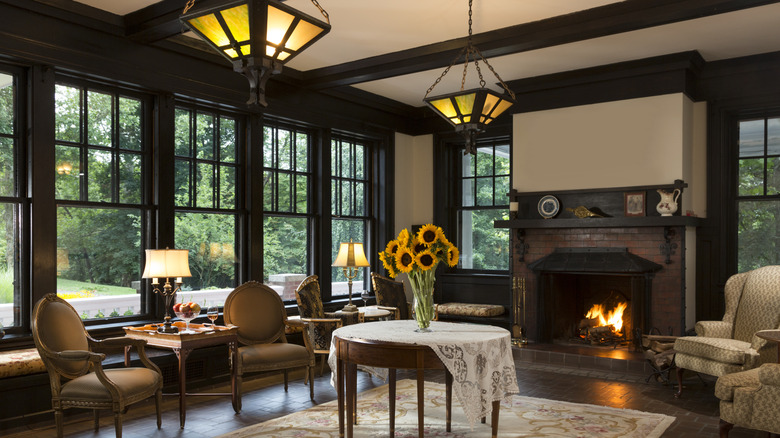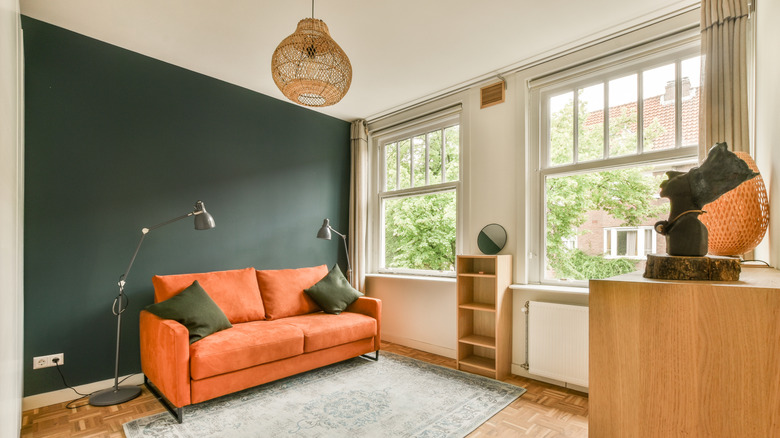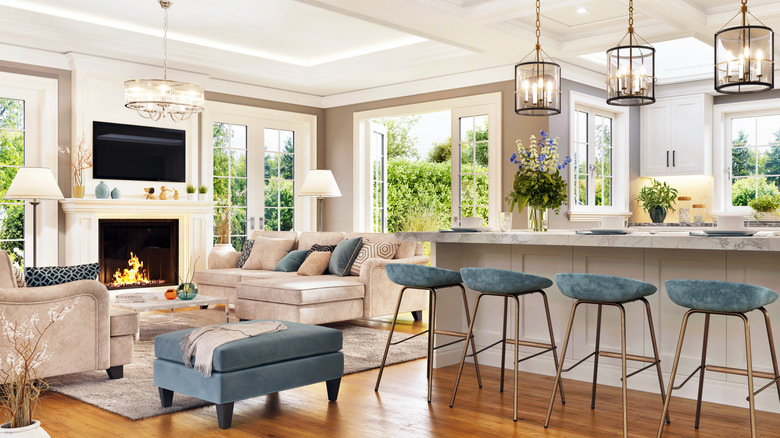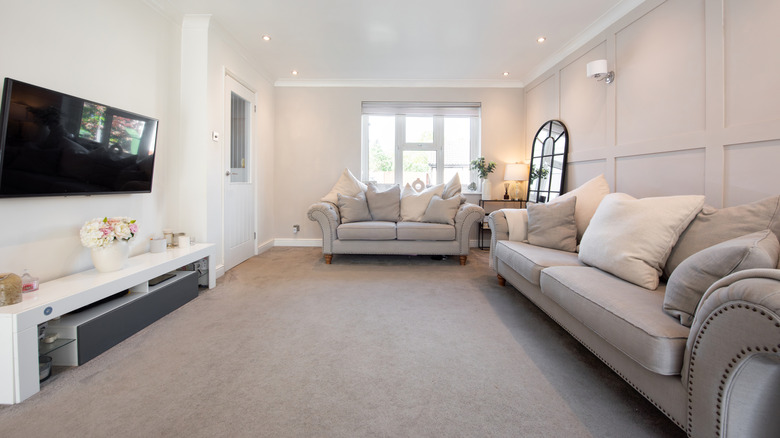5 Once-Popular Living Room Trends That Are Now Dating Your Home
From movie nights to family meetings, your living room serves as the backdrop for so many memories with friends and family. It needs to be a cozy, comfortable, and functional space, but that doesn't mean you have to sacrifice style. In fact, your living room can be an ideal place in the home to showcase your specific tastes and personality. What does your living room's decor say about you? If you have a matchy-matchy design, too much carpeting, or a loud accent wall, it could tell visitors that you're stuck in the past when it comes to living room trends. Design trends come and go for all rooms — there are even dining room trends that are making your home look dated. Looking at the once-popular trends that are fading from the spotlight can help you plan updates to your living space.
Your living room is an area where you can showcase your interests with unique, curated furniture pieces and artwork that tells a story. Modern living rooms feature furniture arrangements that make conversations easy. They use durable materials and lasting furniture pieces instead of mass-produced fast furniture that wears out quickly. Moody color palettes, statement lighting fixtures, and vintage pieces that support sustainability are all part of the current trendy living room design principles. To help you achieve this aesthetic, learn more about five of the most common outdated living room trends and tips on how to modernize these elements.
Overly matching furniture and decor
As you're wandering through a furniture store that's filled with coordinating couches and chairs, you may wonder: Are matching furniture sets going out of style? Many designers say yes. Sure, it's easy to pick a matching furniture set you like and move onto the next design decision. You know the pieces look good together, and it doesn't take much effort. But matching sets also take the personality out of the room and make it look too monotonous. The same goes for decor pieces, light fixtures, and other design elements that match. If everything looks the same, nothing stands out to add a unique touch to the living room. Instead, focus on pieces that serve a purpose and make your living room both comfortable and inviting. Adding high-quality pieces over time helps you build an eclectic look while investing in items that last.
However, focusing on mismatched furniture doesn't mean you should choose pieces blindly. Tying them together with shared characteristics helps create a coordinated, curated look. Start with scale and proportion. The sizes of the pieces should fit together well without one being disproportionately large or small. Finding something similar between the pieces, such as a common color, fabric, texture, pattern, or style, helps them work well together. Look for furniture and decorations that balance each other and add depth to the space.
Excessive formality
Formal living rooms serve as a space for entertaining guests. The idea is to make a good impression on guests with fancy decor and furniture. They often use classic, upscale design features, such as chandeliers and wall sconces, traditional framed artwork, and muted color palettes. However, furniture associated with formal living rooms is often less comfortable than informal living room spaces. When your living room is too formal, it lacks flexibility and may not fit your family's activities. The upscale look and uncomfortable furniture make the room less appealing to actually spend time in, so you may not get much use out of your living room.
In new construction homes, separate formal living rooms often get left out of the floor plan in favor of more practical, comfortable, versatile spaces. If your current living room is overly formal, find ways to loosen it up with comfortable, casual furniture pieces that work well for watching TV, doing homework, entertaining, and hanging out with your family. Aim for durability with sturdy furniture frames and soft yet durable fabrics that hold up to repeated use. Plants, family heirlooms, throw blankets, and warm colors help add to the casual, welcoming look as well.
Bold accent walls
To many designers, accent walls are going out of style — or at least some types of accent walls are outdated. There are several critical accent wall mistakes you should avoid making at all costs to create a modern, welcoming look. A classic accent wall technique is to choose a bold or dark solid color for the wall. This method definitely makes the wall stand out, but probably not for the right reasons. It can become overwhelming or distract people when they walk in the room. A bold accent wall can also make the rest of the room feel unfinished or lacking.
If you want to use a bold color or a wallpaper, consider using it on all four walls instead of just one. You could even try color drenching, which is a popular trend where every surface (including the ceiling and trim) is painted the same color. Or create a bold look by just wallpapering your ceiling. This can add character to a room without architectural features, make the room feel larger, and hide ceiling flaws.
Alternatively, if you want to stick with an accent wall, try a more subtle approach. One option is adding texture to a wall while keeping the paint color the same as the rest of the room. Examples include faux brick, textured compound, textured paint, or wood paneling. If you prefer wallpaper, choose a subtle pattern with a color palette that blends with the rest of the room. Strike a balance between making the wall noticeable without it taking over the room.
Open floor plans
Open floor plans give the illusion of more space and keep people connected while they're using different parts of the space, but they also have several drawbacks. Are open-concept floor plans going out of style and is the look dating your living room? The answer is trending toward yes in recent years. Having one large, open space takes away privacy and can sometimes feel loud and overwhelming. It also leaves you with less wall space for decorating and can give you an unattractive view of a messy kitchen while you're trying to relax. That's why many homeowners are leaning more toward semi-open floor plans over open concept homes.
If you're doing a complete renovation or building a new home, consider creating more division between the rooms. With a semi-open floor plan, you still have connection between the spaces, but you also incorporate some dividers into the design. One example is installing sliding barn doors over large doorways so you can have the room open or closed. Shelving also offers a functional divider with space to store and display items while also partially blocking the view and sound between the rooms. Half walls also offer more division for spaces where you don't wall a full wall separating the rooms. If you don't want to make structural changes, arrange your furniture to create more division between the living room and kitchen. Also ensure that your living room is grounded with a large area rug to really define the space.
Thick carpets and drapes
Just like carpet in bathrooms and kitchens has all but disappeared, thick wall-to-wall carpeting is also becoming a thing of the past in many living rooms. More people prefer the warmth and durability of wood or luxury vinyl plank floors for living spaces over carpet. Plush carpet takes more work to maintain and can become stained or matted easily. For people with allergies, carpet can also be a nightmare, since dirt, pollen, and other allergens stick in the fibers and are difficult to remove, even with regular vacuuming. Plus, this flooring choice doesn't last as long as wood flooring. To keep the room comfortable and warm, position a large area rug in your seating area instead of choosing full carpeting. When choosing an area rug, consider a size that allows all of the furniture to sit on the rug. If that's not possible, aim for a rug size that allows at least the front legs of all furniture pieces to sit on it.
Another soft surface where you can go wrong in a living room is with the window coverings. Heavy drapes block natural light during the day, which can make your living room seem darker. Dark-colored fabrics on your window coverings add to the closed-off feeling. Layering lighter window coverings gives you the privacy you want while allowing you to control how much light enters the room. For example, you might pair light-colored, thermal, insulated blinds with sheer curtains to create an energy-efficient, finished look that lets you get lots of natural light.
